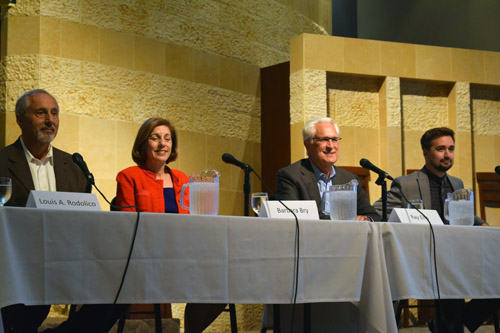
Story by Donald H. Harrison; photos by Shor M. Masori

SAN DIEGO—Four candidates in San Diego’s affluent First City Council District indicated they want the large cross atop Mount Soledad to stay in place. At a Men’s Club-sponsored forum at Congregation Beth Israel, which lies within their councilmanic district, all four were non-committal about whether they favored construction of a new Hillel Center across the street from the UCSD campus.
The First District, which includes such neighborhoods as La Jolla, University City and Carmel Valley, includes both the long disputed Mount Soledad Cross and the proposed Hillel House.
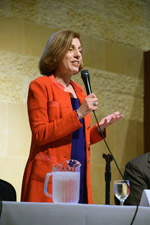
A timekeeper rang a bell indicating one minute was up as Barbara Bry, a Jewish Democratic businesswoman, was answering the question about the cross, but she told San Diego Jewish World after the forum that the city had spent millions of dollars defending the 43-foot high cross—and now that the cross has passed from the city’s jurisdiction to the federal government and on to a nonprofit group – “I am fine with it being there.”
Louis A. Rodolico, a retired architect and a Democrat, commented that the controversy about the cross “goes to whether you consider it a religious symbol or a symbol of military sacrifice and for those soldiers who see the cross in that light we have to give the respect to them that the symbol remain.” He added “I’d like to see the cross remain not because I grew up Christian but because I believe it is a symbol of sacrifice and should be respected that way.”
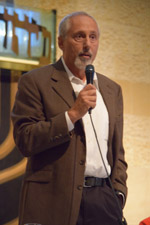
While originally standing atop Mount Soledad as a lone cross—below which Easter Sunrise services were routinely scheduled—after a lawsuit was brought in 1989 to have the cross removed from public land, a group known as the Mount Soledad Memorial Association erected monuments bearing engraved photographs and short descriptions of veterans who fought in American wars. While predominantly Christian, some of those markers bear Jewish stars.
From the audience, Ernest (Ernie) Abbit came to the microphone and with visible emotion told Rodolico: “I just want to remind you that there are Jewish men and women and many of other religious persuasions who gave their lives.”
Kyle Heiskala, a politically independent councilmanic aide to termed-out incumbent Councilwoman Sherri Lightner, a Democrat, said that the cross matter is out of the council’s hands given the fact that the cross is “now operated by a nonprofit and that it is no longer anything that the city has any jurisdiction over.”
Ray Ellis, a Republican businessman, agreed saying, “it is operating under a legally formed 501 c3 and I believe it should be able to operate that way. I do agree with Lou, that this is a memorial and we can look at it in that light as well.”
A fifth candidate, Bruce Lightner, husband of the incumbent city councilwoman, did not attend the forum. The top two candidates in the June 7 election will move on to a general election in November, unless one candidate attains a majority of the votes cast
The cross had been a matter of litigation for more than a quarter century, with the most recent wrinkle being that after courts said the federal government had to either move the cross, or sell the land under it, Congress decided to deed the land around the cross to the Mount Soledad Memorial Association. Earlier in the long fight, the City of San Diego had tried to sell the land to the same association, but the courts ruled the sale unconstitutional on the grounds that its terms were so restrictive no other organization could reasonably use the land. Now the matter of Congress transferring the land is under review by the plaintiffs, so the case might yet continue.
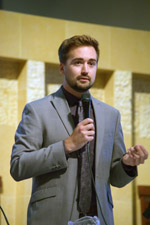
The Hillel Student Center has been opposed for years by neighbors in the area of La Jolla across the street from the UCSD campus. They have argued that it will cause traffic, parking and noise problems. Hillel has argued that it will primarily serve students who will walk from the campus, not drive, and that Hillel’s planned programming and architecture make noise problems unlikely
In her answer, Bry said that “a land use decision is considered quasi-judicial. That means if any of us take a public position of this issue and it comes before the City Council we cannot vote for it.” Noting that she has Jewish and Christian friends on both sides of the issue, she said: “I am sure that you all want your next council representative to be able to participate in whatever goes or doesn’t go on that piece of land.”
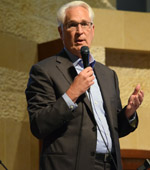
Rodolico spent his one-minute answering time discussing the cross, and did not address the Hillel issue.
Heiskala, a former student at UCSD, said “I am overall supportive of all student groups in the university having their student center and working with all the stakeholders involved to make sure that all the concerns are met, especially with the residents and students so there should be a good balanced outcome.”
Ellis said he recently met with Rabbi David Singer, the director of UCSD Hillel – which now operates out of small offices—“to get updated on where that is (in the process). It is in the draft environmental impact report stage. There was lots of feedback from the community and I know when I talk to folks as I walk those neighborhoods around the Hillel site, there is pro and against, but I do think there are some misconceptions and I think going through this process with the raft EIR will help clarify some of those misconceptions that are in the community.”
*
Harrison is editor of San Diego Jewish World. He may be contacted via donald.harrison@sdjewishworld.com. Comments intended for publication in the space below MUST be accompanied by the letter writer’s first and last name and by his/ her city and state of residence (city and country for those outside the United States.)